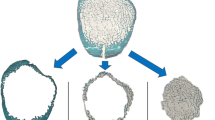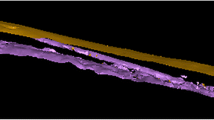Abstract
Introduction
Static cortical bone histomorphometry utilised in forensic age-at-death estimation generally examines only the anterior femoral mid-shaft, as biomechanical strain at the posterior femur is thought to result in increased bone remodelling, osteon density and adversely affect age-at-death estimates. As osteon density increases there is a corresponding decrease in geometric variables, such as osteon area and Haversian canal diameter. The present study tests whether the inverse relationship between osteon density and osteon geometry is reflected in a modern documented Australian sample, and if this relationship differs between the anterior and posterior femoral mid-shaft.
Materials and methods
The study sample comprises 215 femoral microradiographs (117♂ 98♀) of recorded age (18‒97 years) from the Melbourne Femur Reference Collection (MFRC). The following variables were measured in Image J across six 1 mm2 regions of interest (ROIs) from the anterior and posterior; mean intact and fragmentary secondary osteon count, osteon population density, osteon and Haversian canal area, perimeter, and diameter.
Results
Osteon area was positively correlated with Haversian canal size and shape metrics, and negatively correlated with osteon density. Chronological age was significantly correlated with most variables. There were significant between-group effects between the youngest (18‒34 years) and all other age groups (35‒49, 50–74 and 75 + years) for both regions.
Conclusion
Our findings support an increased rate of remodelling associated with decreases in osteon geometry in the anterior and posterior femur. Future studies should examine static osteon histomorphometry using anterior and posterior measurements in larger samples of documented age and sex.





Similar content being viewed by others
Data availability
The data (microradiographs) that support the findings of this study are available from the Melbourne Femur Research Collection. Restrictions apply to the availability of these data, which were used under permission for this study. They are not publicly available due to privacy or ethical restrictions, requests for access can be made to: https://dental.unimelb.edu.au/research/melbourne-femur-research-collection#about.
References
Stout SD, Crowder C (2012) Bone remodelling, histomorphology, and histomorphometry. In: Crowder C, Stout SD (eds) Bone histology: an anthropological perspective. CRC Press, Boca Raton, pp 1–22
Recker RR (ed) (1983) Bone histomorphometry: techniques and interpretation. CRC Press, Boca Raton
Ericksen MF (1991) Histologic estimation of age at death using the anterior cortex of the femur. Am J Phys Anthropol 84:171–179. https://doi.org/10.1002/ajpa.1330840207
Wachter NJ, Krischak GD, Mentzel M, Sarkar MR, Ebinger T, Kinzl L, Claes L, Augat P (2002) Correlation of bone mineral density with strength and microstructural parameters of cortical bone in vitro. Bone 31:90–95. https://doi.org/10.1016/S8756-3282(02)00779-2
Lanyon LE, Goodship AE, Pye C, MacFie J (1982) Mechanically adaptive bone remodelling. J Biomech 15:141–154
Raab DM, Crenshaw TD, Kimmel DB, Smith EL (1991) A histomorphometric study of cortical bone activity during increased weight-bearing exercise. J Bone Miner Res 6:741–749
Yamada S, Tadano S, Fujisaki K (2011) Residual stress distribution in rabbit limb bones. J Biomech 44:1285–1290
Miszkiewicz JJ (2016) Investigating histomorphometric relationships at the human femoral midshaft in a biomechanical context. J Bone Miner Metab 34:179–192. https://doi.org/10.1007/s00774-015-0652-8
Schaffler MB, Burr DB (1984) Primate cortical bone microstructure: relationship to locomotion. Am J Phys Anthropol 65:191–197. https://doi.org/10.1002/ajpa.1330650211
Robling AG, Stout SD (2003) Histomorphology, geometry, and mechanical loading in past populations. In: Aggrawal A, Stout SD (eds) Bone loss and osteoporosis: an anthropological perspective. Springer, Boston, pp 189–205
van Oers RFM, Ruimerman R, van Rietbergen B, Hilbers PAJ, Huiskes R (2008) Relating osteon diameter to strain. Bone 43:476–482. https://doi.org/10.1016/j.bone.2008.05.015
Ural A, Vashishth D (2006) Interactions between microstructural and geometrical adaptation in human cortical bone. J Orthop Res 24:1489–1498. https://doi.org/10.1002/jor.20159
Buikstra JE, Ubelaker DH (1994) Standards for data collection from human skeletal remains. In: Arkansas archaeological survey research series 44. Arkansas Archaeological Survey, Fayteville, AR
Crowder CM, Andronowski JM, Dominguez VM (2018) Bone histology as an integrated tool in the process of human identification. In: Latham KE, Bartelink EJ, Finnegan M (eds) New perspectives in forensic human skeletal identification. Academic Press, Elsevier, pp 201–213. https://doi.org/10.1016/B978-0-12-805429-1.00018-1
Han SH, Kim SH, Ahn YW, Huh GY, Kwak DS, Park DK, Lee UY, Kim YS (2009) Microscopic age estimation from the anterior cortex of the femur in Korean adults. J Forensic Sci 54:519–522
Martrille L, Irinopoulou T, Bruneval P, Baccino E, Fornes P (2009) Age at death estimation in adults by computer-assisted histomorphometry of decalcified femur cortex. J Forensic Sci 54:1231–1237. https://doi.org/10.1111/j.1556-4029.2009.01178.x
Dominguez VM, Mavroudas S (2019) Bone histology for skeletal age-at-death estimation. In: Adserias-Garriga J (ed) Age estimation. Academic Press, Elsevier, pp 145–159. https://doi.org/10.1016/B978-0-12-814491-6.00010-8
Chan AHW, Crowder CM, Rogers TL (2007) Variation in cortical bone histology within the human femur and its impact on estimating age at death. Am J Phys Anthropol 132:80–88. https://doi.org/10.1002/ajpa.20465
Thompson D (1979) The core technique in the determination of age at death in skeletons. J Forensic Sci 24:902–915
Clement JG, Thomas CDL (2012) The melbourne femur collection: how a forensic anthropological collection came to have broader applications. In: Crowder C, Stout SD (eds) Bone histology : an anthropological perspective. CRC Press, Boca Raton, pp 327–339
Thomas C, Stein M, Feik S, Wark J, Clement J (2000) Determination of age at death using combined morphology and histology of the femur. J Anatomy 196:463–471
Stein MS, Feik SA, Thomas CDL, Clement JG, Wark JD (1999) An automated analysis of intracortical porosity in human femoral bone across age. J Bone Miner Res 14:624–632. https://doi.org/10.1359/jbmr.1999.14.4.624
Britz HM, Thomas CDL, Clement JG, Cooper DML (2009) The relation of femoral osteon geometry to age, sex, height and weight. Bone 45:77–83. https://doi.org/10.1016/j.bone.2009.03.654
Bertelsen PK, Clement JG, Thomas CDL (1995) A morphometric study of the cortex of the human femur from early childhood to advanced old age. Forensic Sci Int 74:63–77. https://doi.org/10.1016/0379-0738(95)01738-5
Preibisch S, Saalfeld S, Tomancak P (2009) Globally optimal stitching of tiled 3D microscopic image acquisitions (in eng). Bioinformatics (Oxford, England) 25:1463–1465. https://doi.org/10.1093/bioinformatics/btp184
Schindelin J, Arganda-Carreras I, Frise E, Kaynig V, Longair M, Pietzsch T, Preibisch S, Rueden C, Saalfeld S, Schmid B (2012) Fiji: an open-source platform for biological-image analysis. Nat Meth 9:676–682
Schneider CA, Rasband WS, Eliceiri KW (2012) NIH Image to ImageJ: 25 years of image analysis. Nat Meth 9:671–675. https://doi.org/10.1038/nmeth.2089
Rueden CT, Schindelin J, Hiner MC, DeZonia BE, Walter AE, Arena ET, Eliceiri KW (2017) Image J2: ImageJ for the next generation of scientific image data. BMC Bioinformatics 18:529
Gocha TP, Agnew AM (2016) Spatial variation in osteon population density at the human femoral midshaft: histomorphometric adaptations to habitual load environment. J Anat 228:733–745. https://doi.org/10.1111/joa.12433
Crowder C, Stout SD (2012) Bone histology : an anthropological perspective. CRC Press, Boca Raton
Maggio A, Franklin D (2019) Histomorphometric age estimation from the femoral cortex: a test of three methods in an Australian population. Forensic Sci Int 303:109950. https://doi.org/10.1016/j.forsciint.2019.109950
Koo TK, Li MY (2016) A guideline of selecting and reporting intraclass correlation coefficients for reliability research. J Chiropr Med 15:155–163. https://doi.org/10.1016/j.jcm.2016.02.012
Cohen J (1988) Statistical power analysis for the behavioral sciences, 2nd edn. Lawrence Erlbaum Associates, Hillsdale, NJ
Skedros JG, Knight AN, Clark GC, Crowder CM, Dominguez VM, Qiu S, Mulhern DM, Donahue SW, Busse B, Hulsey BI, Zedda M, Sorenson SM (2013) Scaling of Haversian canal surface area to secondary osteon bone volume in ribs and limb bones. Am J Phys Anthropol 151:230–244. https://doi.org/10.1002/ajpa.22270
Seeman E (2002) Pathogenesis of bone fragility in women and men. Lancet 359:1841–1850. https://doi.org/10.1016/S0140-6736(02)08706-8
Thomas CDL, Feik SA, Clement JG (2005) Regional variation of intracortical porosity in the midshaft of the human femur: age and sex differences. J Anat 206:115–125. https://doi.org/10.1111/j.1469-7580.2005.00384.x
Cosgriff-Hernandez M-T (2012) Histomorphometric estimation of age at death using the femoral cortex: a modification of established methods. The Ohio State University, Columbus
Robling AG, Castillo AB, Turner CH (2006) Biomechanical and molecular regulation of bone remodeling. Annu Rev Biomed Eng 8:455–498. https://doi.org/10.1146/annurev.bioeng.8.061505.095721
Squires K, Booth T, Roberts CA (2019) The Ethics of sampling human skeletal remains for destructive analyses. In: Squires K, Errickson D, Márquez-Grant N (eds) Ethical approaches to human remains: a global challenge in bioarchaeology and forensic anthropology. Springer International Publishing, Cham, pp 265–297. https://doi.org/10.1007/978-3-030-32926-6_12
Acknowledgements
The authors thank Dr Rita Hardiman (Melbourne Dental School, The University of Melbourne) for facilitating access to the Melbourne Femur Reference Collection as well as everyone involved in the donation and preparation of the microradiographs used in this study. The authors would also like to thank the anonymous reviewers for their comments. This research was supported by an Australian Government Research Training Program (RTP) Scholarship.
Funding
This research did not receive any specific grant from funding agencies in the public, commercial, or not-for-profit sectors.
Author information
Authors and Affiliations
Contributions
AM: conceptualization (lead); data curation (lead); formal analysis (lead); methodology (lead); validation (lead); visualization (lead); writing-original draft (lead); writing-review and editing (equal). df: conceptualization (supporting); methodology (supporting); supervision (lead); writing-original draft (supporting); writing-review and editing (equal).
Corresponding author
Additional information
Publisher's Note
Springer Nature remains neutral with regard to jurisdictional claims in published maps and institutional affiliations.
Supplementary Information
Below is the link to the electronic supplementary material.
774_2021_1204_MOESM1_ESM.png
Supplementary file1 Supplementary Fig.1: Scattergrams illustrating the distribution of data from anterior measurements in age group categories. Each scattergram shows five regression lines; one per age group and one representing the entire dataset (thicker black line) (PNG 136 KB)
774_2021_1204_MOESM2_ESM.png
Supplementary file2 Supplementary Fig. 2: Scattergrams illustrating the distribution of data from posterior measurements in age group categories. Each scattergram shows five regression lines; one per age group and one representing the entire dataset (thicker black line) (PNG 136 KB)
About this article
Cite this article
Maggio, A., Franklin, D. An examination of histomorphometric relationships in the anterior and posterior human femoral cortex. J Bone Miner Metab 39, 649–660 (2021). https://doi.org/10.1007/s00774-021-01204-7
Received:
Accepted:
Published:
Issue Date:
DOI: https://doi.org/10.1007/s00774-021-01204-7




